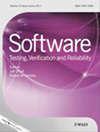GPU acceleration of finite state machine input execution: Improving scale and performance
IF 1.2
4区 计算机科学
Q3 COMPUTER SCIENCE, SOFTWARE ENGINEERING
引用次数: 0
Abstract
Model‐based development is a popular development approach in which software is implemented and verified based on a model of the required system. Finite state machines (FSMs) are widely used as models for systems in several domains. Validating that a model accurately represents the required behaviour involves the generation and execution of a large number of input sequences, which is often an expensive and time‐consuming process. In this paper, we speed up the execution of input sequences for FSM validation, by leveraging the high degree of parallelism of modern graphics processing units (GPUs) for the automatic execution of FSM input sequences in parallel on the GPU threads. We expand our existing work by providing techniques that improve the performance and scalability of this approach. We conduct extensive empirical evaluation using 15 large FSMs from the networking domain and measure GPU speed‐up over a 16‐core CPU, taking into account total GPU time, which includes both data transfer and kernel execution time. We found that GPUs execute FSM input sequences up to 9.28× faster than a 16‐core CPU, with an average speed‐up of 4.53× across all subjects. Our optimizations achieve an average improvement over existing work of 58.95% for speed‐up and scalability to large FSMs with over 2K states and 500K transitions. We also found that techniques aimed at reducing the number of required input sequences for large FSMs with high density were ineffective when applied to all‐transition pair coverage, thus emphasizing the need for approaches like ours that speed up input execution.有限状态机输入执行的GPU加速:提高规模和性能
基于模型的开发是一种流行的开发方法,其中软件是基于所需系统的模型实现和验证的。有限状态机(fsm)作为系统模型被广泛应用于许多领域。验证一个模型是否准确地代表了所需的行为,涉及到大量输入序列的生成和执行,这通常是一个昂贵且耗时的过程。在本文中,我们利用现代图形处理单元(GPU)的高度并行性,在GPU线程上并行自动执行FSM输入序列,从而加快了FSM验证输入序列的执行速度。我们通过提供改进这种方法的性能和可伸缩性的技术来扩展我们现有的工作。我们使用来自网络领域的15个大型fsm进行了广泛的经验评估,并测量了16核CPU上GPU的速度,同时考虑了GPU的总时间,其中包括数据传输和内核执行时间。我们发现gpu执行FSM输入序列的速度比16核CPU快9.28倍,在所有受试者中平均速度提高4.53倍。我们的优化在现有工作的基础上实现了58.95%的提速和可扩展性,可扩展到具有超过2K状态和500K转换的大型fsm。我们还发现,旨在减少高密度大型fsm所需输入序列数量的技术在应用于全过渡对覆盖时是无效的,因此强调需要像我们这样加快输入执行的方法。
本文章由计算机程序翻译,如有差异,请以英文原文为准。
求助全文
约1分钟内获得全文
求助全文
来源期刊

Software Testing Verification & Reliability
工程技术-计算机:软件工程
CiteScore
3.70
自引率
0.00%
发文量
34
审稿时长
>12 weeks
期刊介绍:
The journal is the premier outlet for research results on the subjects of testing, verification and reliability. Readers will find useful research on issues pertaining to building better software and evaluating it.
The journal is unique in its emphasis on theoretical foundations and applications to real-world software development. The balance of theory, empirical work, and practical applications provide readers with better techniques for testing, verifying and improving the reliability of software.
The journal targets researchers, practitioners, educators and students that have a vested interest in results generated by high-quality testing, verification and reliability modeling and evaluation of software. Topics of special interest include, but are not limited to:
-New criteria for software testing and verification
-Application of existing software testing and verification techniques to new types of software, including web applications, web services, embedded software, aspect-oriented software, and software architectures
-Model based testing
-Formal verification techniques such as model-checking
-Comparison of testing and verification techniques
-Measurement of and metrics for testing, verification and reliability
-Industrial experience with cutting edge techniques
-Descriptions and evaluations of commercial and open-source software testing tools
-Reliability modeling, measurement and application
-Testing and verification of software security
-Automated test data generation
-Process issues and methods
-Non-functional testing
 求助内容:
求助内容: 应助结果提醒方式:
应助结果提醒方式:


